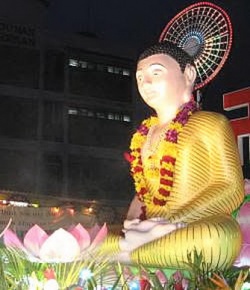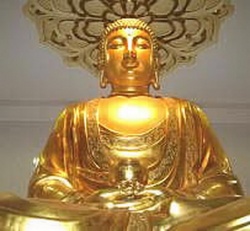Conventional and Ultimate Truths
Ultimate truths of Buddhism are different from the conventional truths of everyday life. This can be confusing for the thoughtful person. For instance, they might think, if there is no self theory in Buddhism, how come I write referring to myself and to others? One reason is that writing which does not refer to the self is difficult to understand.
Another question that arises, is: Why are certain qualities developed on the Path, if they are part of the worldly misundersting? For instance, the Noble Eightfold Path is a composite thing and therefore part of the worldly misunderstanding.
Conventional Truths
In Buddhism, the conventional truth of things is how they appear. For instance, some objects appear to be permanent and to exist independently. Of course, we know they aren't really permanent and independent. But we act and think as if they were. We speak of the self as if it was unchanging and as independent of the circumstances. Conventionally, I might say, "I was sad, yesterday". I might say, "I am happy now." This conventional truth is a misunderstanding, because it leads to suffering.
Ultimate Truths
The ultimate truth in Buddhism is how things really are. They are ever-changing and dependent on circumstances. Suppose I was sad yesterday (because of sad circumstances). But I am happy now (because of happy circumstances). However, I do not think that I am that sad person of yesterday. It would be untrue to say, "I am that sad person", because at the moment I am happy and enjoying happy circumstances. I can't be happy and sad. So I am not that sad person of yesterday. Also, I do not think "I am this happy person of the present moment". True, I feel happy now, but I know that tomorrow, when doing routine shopping, I won't be happy or sad, because the circumstances will be neutral, and I will be in a neutral mood.
Buddhists do not believe that they are any of these selves, and they do not believe they are all of them. They believe there is happiness, sadness, and neutrality, but but no person is involved. There is no I (or me, or mine). This is an ultimate truth. If they believed they were any of these selves, they would be attached to one or the other of these selves. Such attachment would bring about suffering.
It would bring about suffering like this. If they became attached to a happy self, they would want to be happy all the time. That would be fine for happy occasions. But sometimes it would be wrong. For instance, smiling and laughing at a funeral. Or if they became attached to a sad self, they would be sad inappropriately, as when another spoke of their good fortune. As an ultimate truth, Buddhists do not identify with a self.
However, Buddhists do answer to their names and refer to themselves, other people and things by name (As Gotama did). But these are conventional, not ultimate truths.
The examples of selves above involved the emotions. Some people think they are their emotions. "We are love", for instance. Others believe they are their bodies. This is a common belief in science. Yet others believe they are their minds, or parts thereof. As, "I think, therefore I am". All of these are at best conventional truths in Buddhism. As ultimate truths they are false. These topics are taken up later. A self can be only one of the Five Skandhas. And none of these can be something we can rely upon, and so is suffering.
The difference between conventional and ultimate truths is further illustrated by this example. Suppose we look at the sky and see the moon. Let us say the moon is waxing. You might say, "The moon is waxing", meaning it is growing (because later we know we will see more of it in the following days. And when the moon is waning, you might say, "The moon is waning", because later, we will see less of it in the coming days. These are conventional truths. They aren't lies. The moon appears like this. But they aren't ultimate truths (in science).
The growing and shrinking of the moon are conventional truths. But the ultimate truth in science is that the moon is not changing. It does not grow and it does not shrink over the month. Only the reflected light changes. The ultimate truth (in science) is that an observer sees particular visual effects, dependent on the position of the moon and the Earth, and dependent on the observer's position on the Earth.
Ultimate Truths in a World of Delusion
At some stage or the other, people reading about Buddhism will encounter the idea of no-self. They might then think, "If there is no self", then why do the Buddhists talk about "people", "I", "You", "Me" and "Mine". And why did Gotama do so? The reason is in part one of necessity, and in part to reduce suffering.
It is one of necessity because we appear to live in a world of things, real objects, including living beings. Everything in the world is considered a thing (an entity). However, Buddhists believe this way of viewing things is a misunderstanding. In truth, we live in a world of impermanent things which are dependent on causes. They are, consequently, not self-contained and independent. They are not a self.
Because the whole of our experience is this delusional viewpoint, Buddhists have little option but to talk about things as they appear. Like the man in the well, who has no option but to use the well to escape. In this way, Buddhists use the conventional truths of the world as a means to escape delusion, and reduce suffering. Conventional truths are also used as a ladder to ultimate truth.
Buddhists often use conventional truth as a means of leading others to the ultimate truth. When the man trapped in the well has used the mud, debris, water and the well itself to gain his freedom, he no longer needs them. They were valuable when he was trapped, but not valuable when he has his freedom. When he is free, he does not need mud and debris. As essential as they were, he can now leave them behind. In the same way, when a person gains enlightenment, he or she can dispense with much of Buddhism.
Gotama told the story of a man or woman on a journey. They reach a wide river. To cross the river they must spend some hours building a raft. They use the raft to cross the river.
When they have crossed, they think, "This raft has been useful to me, so I will put it on my back and carry it with me." Then another thought occurs. "If I haul this raft around with me, it will slow me down and tire me. And I may never meet another river."
"Isn't it better to leave the raft behind so it might benefit another. And if I do face another river, I can build another raft."
This illustrates conventional truths. They are useful at various stages of the journey, but we discard them when we no longer need them.
However, in order to reduce suffering, before we are enlightened, we need to use the material of the delusional world in order to build a raft to cross the water. For instance, Buddhists are encouraged to form an identity showing ethical behaviour and loving kindness. This identity is not really a self, and is delusional, but it is a way to practice for enlightenment. When the task has been accomplished, even this self can be discarded, like the raft, and the enlightened person acts ethically without the need of a thinking or feeling ethical self. And like the raft, his or her example can be left behind as a guide for others.
Using the delusional world to free ourselves from delusion is like using tinder to light a fire. Just as the tinder is consumed by the fire, so our helpful delusions are dissolved when we attain enlightenment. At the highest levels of practice, the fire is 'burnt out' or blown out (enlightenment). But this does not imply the tinder wasn't necessary. The fact that the tinder does not exist when the fire is alight and when everything flammable is consumed does not mean it wasn't necessary. Without tinder, the fire would not light, and the potential to burn would remain. The defilements would remain awaiting a spark. In the same way, Buddhists use conventional truths to reduce suffering. When suffering is no more, they can be discarded.


